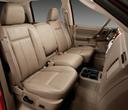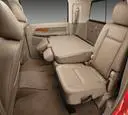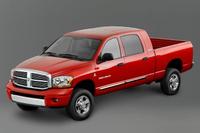2006 Dodge Mega Cab Review
By Thom Cannell
Detroit Bureu
SEE ALSO: New Car Buyer's Guide for Dodge
Is bigger better? Is enormous capacity for tools, people, and cargo a good thing? Dodge is betting a significant number of families, tradesmen, craftsmen, and long haulers will answer yes and their solution is Mega Cab. Mega Cab has the largest pickup cab ever built at 111.1 inches long, with an interior capacity of 143.2 cubic feet. Of that, 72.2 cubic feet can be stuffed full of cargo. Cargo space is not limited to rear seats, footwells, and fold-down seats; behind the rear seat you can fit the largest flat-screen television—in its shipping container—a volume of 7.7 cubic feet.
If you need a load floor to support bulky items, a multitude of boxes, or even toss down a sleeping bag, Mega Cab can give you 16.8 square feet (15607.7 sq cm.) And should you simply want to sit in the rear seat you’ll have more legroom than an S-Class Mercedes, 44.2 inches.
I hear you asking why, why such an enormous cab? Because full-sized crew cab sales now encompass 39% of the total pickup market and Dodge had nothing to sell.
Beginning with a 160.5” wheelbase Ram 2500 Quad Cab Long Box, Dodge engineers removed the standard 8’ box and bolted on a shorter 6’3” box. In the resulting gap, 20” of extra length, half went into a wider door, the remainder into a longer rear sail panel. “Space in a different place” is how Dodge designers and engineers explain it.
Like all 2006 Ram trucks, Mega Cab is significantly redesigned in front. There’s a new headlamp structure filled with twin round halogen lamps and turn signal. The signature crosshair grill is bolder and heavily chromed and the Ram head is now centered on the cross.
 |
Inside, all finishes have been upgraded and the electronics brought into the current generation. Bucket seats and large floor console are optional. That console easily holds three cups or containers of almost any capacity, there’s a niche molded in that is a perfect fit to your cell phone, and another bin for the inevitable profusion of road food.
When it comes to options, Dodge offers a full-screen GPS/DVD navigation system, power sunroof, rear DVD entertainment system (the only twin DVD available from a factory,) and leather or cloth seats are available for either SLT or Laramie models.
 |
Rear seats are flexible in capacity, splitting 60/40 and reclining 22-37°, as well as folding flat. With the floor flattened you could use the rear for sleeping space for two very friendly persons and there are storage bins hidden behind the seats and in the floor for private gear. The rear seat is so far from front ventilation that, like luxury cars, it has its own HVAC outlets and controls.
Dodge promised it had refined the Noise, Vibration, and Harshness with luxury standards in mind. They used polymer constraint layers to capture and reduce power train noises and road noise. Sealing was improved around the A-pillar, doors, and between box and cabin where tremendous amounts of road noise normally leak in. They even added laminated side glass, an expensive luxury car feature.
I began my test winning the coin-toss and opting for a testing the truth of NVH refinement in the rear seat. It is indeed quiet. I could carry on conversations with front passengers and listen to the radio at the same time, feeling the solid thump-thump of the sub-woofer. In fact the Mega Cab is astonishingly quiet in the rear, more like a last-generation Bentley Continental than a truck. It does, however “ride like a truck” when you’re seated in the back. That surprised me until I realized that the Mega Cab is a built on a 2500 platform. This means, depending on model (1500-2500-3500) it is a truck with a minimum GVWR (gross vehicle weight rating) of 8510 pounds, up to 9900 pounds, and a trailer tow capacity of 7750 to 15900. In other words, under the rear passenger’s hips are hefty leaf springs and a solid rear axle. This is not a combination designed for comfort alone, it is designed to work.
While seated in the rear I noticed more head toss and more “jiggle” than a comparable Ford F-150, but that may be an unfair comparison (1500 vs. 2500.) I didn’t get to compare this more robust Ram chassis when it was heavily laden; typically a few hundred pounds does wonders to settle the rear end.
Ever ridden in the back of a luxury car or truck? No air movement, right? You sit and stifle with no heat for the winter, no refreshment in summer. In the Mega Cab I could feel fresh air on my face and there was enough cool air flowing that my legs and feet got cold. From behind the wheel I notice that the interior is not luxurious. Nice, pleasant, handsome, functional, but not luxurious. With the base 4x2 SLT 1500 priced at $32,860 USD and a 3500 Laramie 4x4 going for $48,595—you can option it out to over $50,000—we decide that it is actually inexpensive, if priced by the furlong. This truck is 247.7”, nose to tail.
Dodge offers two powertrains, the signature 5.7-liter Hemi with 345 horsepower (375 pound-feet torque,) and the 5.9-liter inline six Cummins Turbo Diesel with 325 horsepower and massive 610 pound-feet of torque at only 1600 rpm. The Cummins motor is optional on 2500, standard on 3500. I preferred the turbo engine; it’s quiet, revs quickly and easily to over 3000 rpm, and the 6-speed manual transmission is fully synchronized with a none-to-clunky shifter.
Surprisingly for such a massive vehicle, it is pleasant and easy to drive on narrow roads, and easy to maneuver and park if you remember its length. While hardly a sporting truck like the Ram SRT-10, its recirculating ball steering gear is surprisingly precise. The overall driving experience is not much different from standard pickups.
Though inflation-adjusted gasoline prices in the US are similar or less than the 1970s, consumers howl at paying $2.60 per gallon. This giant truck should, according to Dodge, get 14 mpg in the city and 20 on the highway. I doubt it will get 16 highway unless on flat land at 55 mph. The turbo diesel is said to offer a bit better mileage around the towns, and the same on the highway. I can believe that based on personal experience.
Would I have one? I don’t need one and it would rip apart my garage if I tried to park inside. But if I had to transport a soccer team or work crew in comfort, complete with all the luggage and gear, a Mega Cab would be better than a bus.



